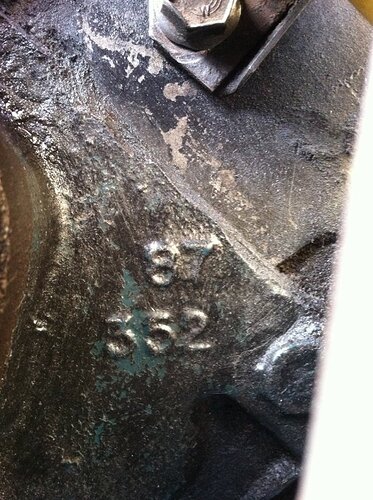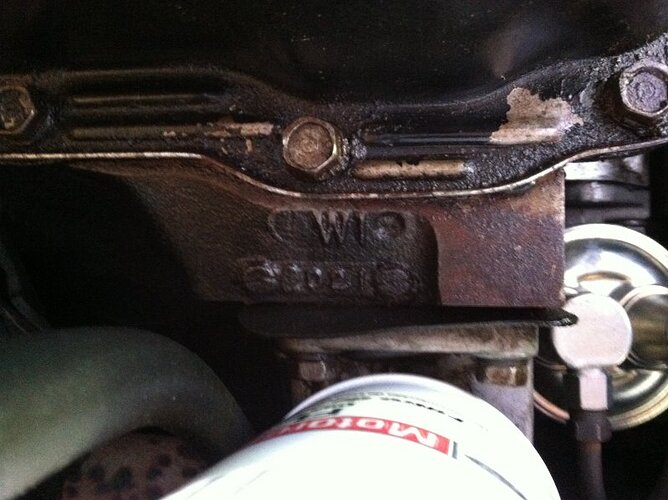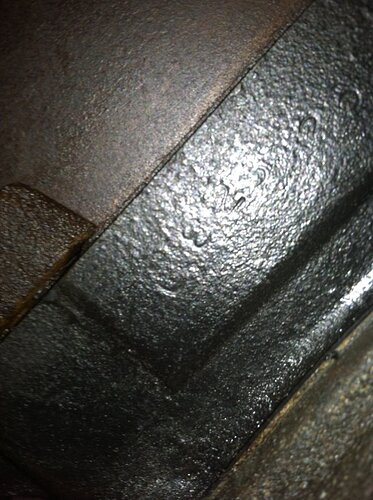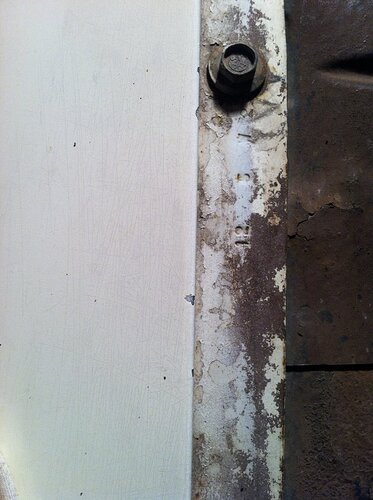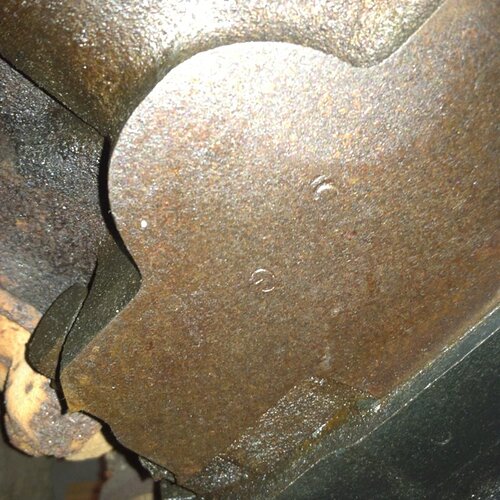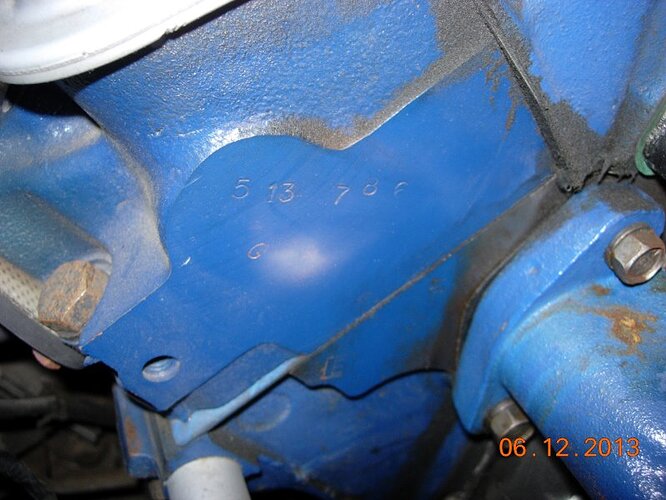Hello - I’m new to the board and have a question that should be easy for experienced members. I have owned my cougar for over twenty years but am now at the point where I have decide if it is worth it to me to invest money in the motor. I have attached a couple of pictures of casting numbers and wanted to get thoughts on whether it is the original block or not. Thanks for your help.
If I am reading the casting date correctly, 0D21=March 21, 1970. I would say it is not original to a 68 Cougar. But; try to clean off the back of the drivers side head and the block just below it and see if you can find numbers stamped in to it. It should have the VIN for your car there if it is original. The 352 cast on the front of the block is common. My 428 has that too.
Thanks- I’ll do that and try to get a picture of it.
I’ve attached the best picture I could get of the block. After 50 years (or so) not exactly conclusive. I think I see a 2 but there isn’t one in my vin…
I was still curious about the W1 above the (?)D21 Does that have any significance or is it like the 352 on most FE big blocks?
Thanks again.
W = West casting line, Dearborn Rouge Plant
1 = First shift (07:30 AM - 4:00 PM)
Thanks Royce. On a related note, when trying to get the picture of the block, I got a picture of the left head, which has a very clear G stamped on it and a less clear 9. Probably not going to help in better understanding the age of the block, but I thought I would mention it…
Good news though, at least my fender is original equipment!
Hi, another question related to this date code. Given the significance of a numbers matching drivetrain to the value of a classic car, I am curious as to how much value is lost when the year code on the engine block is not nearly as clear as the month and day, and the buyer marks the car down for it? In my case the year really doesn’t matter, since the month is four months later than my Marti report, but I’m still curious…
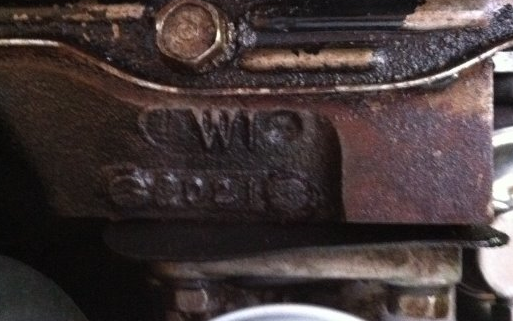
The G 9 is probably stamped there by a machine shop to identify it with the customer’s invoice somehow. It’s not something that would have been done by Mercury.
I think it looks like a 5 - as if they started to do a VIN stamp and changed their mind.
The G might be an assembler or inspector initial. My head has a similar stamp.
I am not trying to hijack this thread, per se, but the title of the topic leaves room for other near topics.
I have a 1970 Cougar Eliminator, Q code, that I bought as a “demonstrator” new car in 1970. The car had 2427 miles on the clock when I took ownership from the dealership in 1970. I was informed that the car had been raced extensively at local drag strips as a promotion and had been known as “The Top Cat”. Needless to say, it was not a numbers matching car, even when I bought it in 1970. While doing restoration on this car (which I have reacquired), I noticed that the casting date on the CJ block was October 31, 1969 while the production date of the car itself was October 3, 1969. I am now replacing parts that were missing and I’ve been poring over the PCV system on my car. It says it is a 1970 car, but the PCV system looks like it came from a 1969 car (or engine).
Now I am wondering about the possibility that the original engine (and a few subsequent engines) had a catastrophic failure which necessitated a complete swap of engines (and PCV system) at some point. That would partially explain the 1969 style PCV system. The other possibility is that there were numerous left-over PCV systems from1969 models when they started building the 1970 models.
Or, if Lincoln-Mercury HAD really supported my car as a factory-stock racecar, then the engine replacement (per LM) would have been a block date beyond Oct/3/69 they mav have gotten that engine from the warranty stock and the one they sent had 1969 PCV on it.
Any thoughts on this, one way or another?
P.S. The heads on the motor are stamped with the vehicle VIN so it is more likely they have done a few shortblocks…
Well the original engine would have to be cast long prior to building the car so it’s gone. No opinion on what you have now except that it’s not original.
Ooops! The casting date on the block is October 31, 1968, not 1969. Is it likely that this engine was sitting around for 49 weeks before being installed into my car? Technically, is it now numbers matching? This might explain everything and the PCV plumbing being 1969 in a 1970 car.
The 428 CJ was a popular motor and was usually in a car within a short number of weeks after casting, so there’s almost no way that’s the original motor. Was there a vin stamp in the block?
VIN stamp on heads is correct. Where to look for VIN stamp on block?
You lucked out! On some CJ motors, the heads got stamped but not the block. If you can find a date coded block and mate it to those heads, you would essentially be “numbers matching” in most people’s eyes.
Thanks for the info. I think I’m going with the story of it being a 1968 block (with 1969 PCV plumbing) that was called into service from Mercury inventory and installed in my 1970 in October 1969 (this might convince the “strong of back, weak of mind” crowd).
On the other hand, I was told by more than one employee of Roger Harmon Motors, San Bernardino, CA, that the motor was blown up more than once. This might explain the casting date of the block but the heads have the correct VIN, 1969-style PCV plumbing, so it IS plausible that this is a (tongue-in-cheek) number’s-matching motor.
'Ya think?
No way anyone would have used 1969 PCV plumbing on a 1970 428CJ. The line didn’t have any and it was not easy to get even through the dealer network. The block casting date means the block got swapped over the years - not unusual. I would sell the PCV setup and buy the proper 1970 stuff if it was mine. Bill at Mansfield Mustang has anything that you might need.
My supposition was that the dealership blew up the original motor (1970 CJ) and it was replaced (by Mercury) from standby stock with a whole motor (albeit a 1969 CJ). This does not explain the proper VIN on the heads though.
Hay Chuck, A thought on your intake. What if the dealer used an Aluminum intake for a while when racing it and put this incorrect one back on? What is the casting date on the intake? Is it correct to the heads?
The code on the intake reads 9G29. So that would be !969, July 29th? That would be numbers matching for the intake. The heads have the VIN stamped on them so they are OK.
One of my early mistakes (in 1971) was to hit a dip at too great a speed and scrape the oil pan enough so that it leaked afterwards. As a 22 year-old, laying on my back and looking up into the block, I remember seeing that the rod caps were the 12-spline type and each rod had numbers in blue paint that said “692” (or “612”, I can’t remember 51 years ago). When I reacquired the car and dropped the pan, the rods were normal so maybe the second owner blew up the engine that I had and then replaced it with the 69 short block. I am the 1st and 4th owner but only me and the second owner have ever driven the car (3rd owner was a car collector not a restorer).
I was also told, at the time of purchase, that the engine was one of 50 Super CJs that had been blueprinted and balanced by Iskendarian in nearby L.A.
